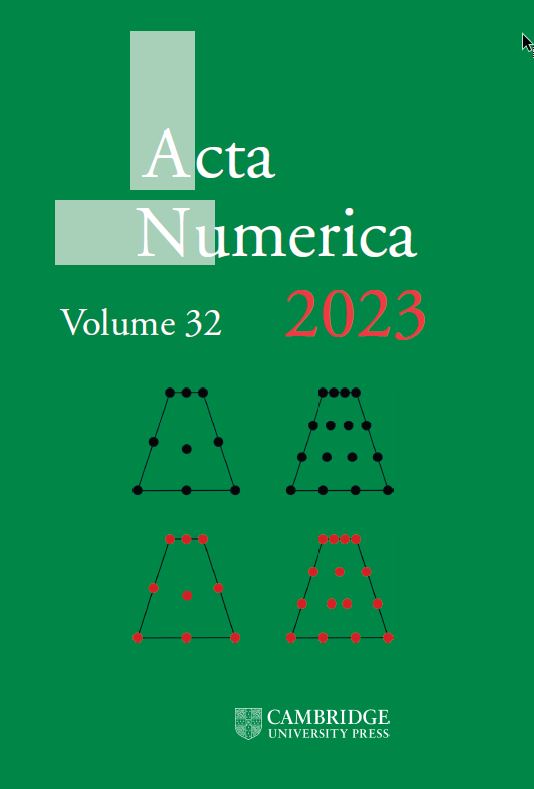代数多重网格方法*
IF 11.3
1区 数学
Q1 MATHEMATICS
引用次数: 168
摘要
本文概述了求解大型方程组的AMG方法,如偏微分方程的离散化。AMG通常被理解为“代数多重网格”的缩写,但它也可以被理解为“抽象多重网格”。实际上,我们在本文中演示了如何以及为什么代数多网格方法可以在更抽象的层面上更好地理解。在文献中,有许多不同的代数多重网格方法已经从不同的角度发展。在本文中,我们试图发展一个统一的框架和理论,可以用来推导和分析不同的代数多网格方法在一个连贯的方式。给定矩阵a $的一个更光滑的$R$,如高斯-塞德尔或雅可比,我们证明了维数$n_{c}$的最优粗空间是第一个$n_{c}$特征向量$\bar{R} a $所对应的特征向量张成的空间(其中$\bar{R}=R+R^{T}-R^{T}AR$)。我们还证明了该最优粗空间可以通过与$\bar{R} a $相关的矩阵的约束迹最小化问题得到,并证明了大多数现有AMG方法的粗空间可以视为该迹最小化问题的近似解。在此基础上,给出了拟最优粗糙空间构造的一般方法,并证明了在适当的假设下,所得到的二阶AMG方法对于问题的大小、系数变化和各向异性是一致收敛的。我们的理论适用于大多数现有的多网格方法,包括标准几何多网格法、经典多网格法、能量最小化多网格法、非光滑和光滑聚集多网格法以及频谱多网格法。本文章由计算机程序翻译,如有差异,请以英文原文为准。
Algebraic multigrid methods *
This paper provides an overview of AMG methods for solving large-scale systems of equations, such as those from discretizations of partial differential equations. AMG is often understood as the acronym of ‘algebraic multigrid’, but it can also be understood as ‘abstract multigrid’. Indeed, we demonstrate in this paper how and why an algebraic multigrid method can be better understood at a more abstract level. In the literature, there are many different algebraic multigrid methods that have been developed from different perspectives. In this paper we try to develop a unified framework and theory that can be used to derive and analyse different algebraic multigrid methods in a coherent manner. Given a smoother $R$ for a matrix $A$ , such as Gauss–Seidel or Jacobi, we prove that the optimal coarse space of dimension $n_{c}$ is the span of the eigenvectors corresponding to the first $n_{c}$ eigenvectors $\bar{R}A$ (with $\bar{R}=R+R^{T}-R^{T}AR$ ). We also prove that this optimal coarse space can be obtained via a constrained trace-minimization problem for a matrix associated with $\bar{R}A$ , and demonstrate that coarse spaces of most existing AMG methods can be viewed as approximate solutions of this trace-minimization problem. Furthermore, we provide a general approach to the construction of quasi-optimal coarse spaces, and we prove that under appropriate assumptions the resulting two-level AMG method for the underlying linear system converges uniformly with respect to the size of the problem, the coefficient variation and the anisotropy. Our theory applies to most existing multigrid methods, including the standard geometric multigrid method, classical AMG, energy-minimization AMG, unsmoothed and smoothed aggregation AMG and spectral AMGe.
求助全文
通过发布文献求助,成功后即可免费获取论文全文。
去求助
来源期刊

Acta Numerica
MATHEMATICS-
CiteScore
26.00
自引率
0.70%
发文量
7
期刊介绍:
Acta Numerica stands as the preeminent mathematics journal, ranking highest in both Impact Factor and MCQ metrics. This annual journal features a collection of review articles that showcase survey papers authored by prominent researchers in numerical analysis, scientific computing, and computational mathematics. These papers deliver comprehensive overviews of recent advances, offering state-of-the-art techniques and analyses.
Encompassing the entirety of numerical analysis, the articles are crafted in an accessible style, catering to researchers at all levels and serving as valuable teaching aids for advanced instruction. The broad subject areas covered include computational methods in linear algebra, optimization, ordinary and partial differential equations, approximation theory, stochastic analysis, nonlinear dynamical systems, as well as the application of computational techniques in science and engineering. Acta Numerica also delves into the mathematical theory underpinning numerical methods, making it a versatile and authoritative resource in the field of mathematics.
 求助内容:
求助内容: 应助结果提醒方式:
应助结果提醒方式:


